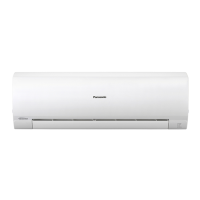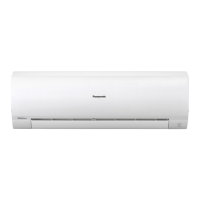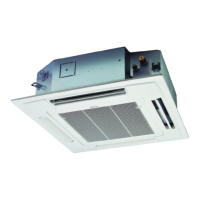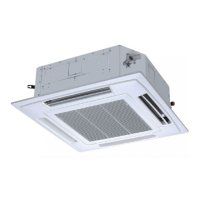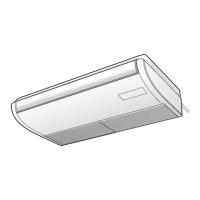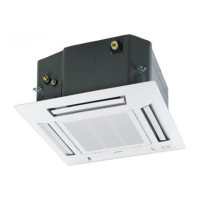18
Drain hose
Slide the drain hose fully onto the drain pan outlet until
the drain hose edge is pushed into the insulation. Check
that the screw holes in the drain bracket and the drain pan
outlet are aligned and securely in contact, then fasten them
with the screw. (After attaching the drain hose, check that it
is attached securely.) (Fig. 3-66)
Fig. 3-66
Drain cap
Use a Phillips screwdriver to push the drain cap in firmly.
(If it is difficult to push in, wet the cap with water first.)
(3) Install the indoor unit on the rear panel.
(4) Connect the tubing and wiring led inside from outdoors.
(5) After completing a leak test, bundle the tubing together
with armoring tape and store it inside the tubing storage
area at the back of the indoor unit and hold it with clamps.
(Fig. 3-67)
Fig. 3-67
To unmount indoor unit
Press the 2
marks on the lower part of the indoor unit and
unlatch the tabs. Then lift the indoor unit and unmount.
(Fig. 3-68)
Fig. 3-68
3-19. Drain Hose
a) The drain hose should be slanted downward to the
outdoors. (Fig. 3-69)
Fig. 3-69
b) Never allow a trap to form in the course of the hose.
c) If the drain hose will run in the room, insulate the hose with
insulation* so that chilled condensation will not damage
furniture or floors. (Fig. 3-70)
Fig. 3-70
* Foamed polyethylene or its equivalent is recommended.
WARNING
Do not supply power to the unit or operate it until all tubing
and wiring to the outside unit are completed.
Risk of Electric Shock
Screw hole
Drain pan outlet
Drain hose
Screw
Drain bracket
Drain hose
Drain bracket
Insulation
Refrigerant tubing
Inter-unit wiring
Push
Indoor
unit
Slant
Drain
hose
Insulation material
(locally purchased)
must be used.
Condensation
PanaIndoor-337012Eng.indb18PanaIndoor-337012Eng.indb18 2012/03/2116:20:482012/03/2116:20:48

